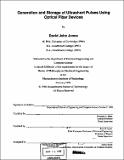Generation and storage of ultrashort pulses using optical fiber devices
Author(s)
Jones, David John, 1969-
DownloadFull printable version (8.991Mb)
Other Contributors
Massachusetts Institute of Technology. Dept. of Electrical Engineering and Computer Science.
Advisor
Hermann A. Haus and Erich P. Ippen.
Terms of use
Metadata
Show full item recordAbstract
Three different types of optical fiber devices were investigated for this thesis: actively modelocked fiber lasers, optical fiber ring buffers, and passively mode-locked fiber lasers. Intra-cavity soliton compression was employed in an actively mode-locked fiber laser to reduce the pulse width by a factor of 4.4 below the pulse widths predicted by standard active mode-locking theory. Stability regions for these solitons were mapped out and compared to theoretical predictions. In the second device the dynamics of a 5 Gbit/sec packet of ONES and ZEROS loaded into a phase modulated optical fiber ring buffer were experimentally investigated. A new mode of operation was explored where the cavity length of the buffer was slightly detuned from the modulation frequency that was driving the phase modulator. An investigation into the conditions for successful loading and the storage behavior was performed. In addition, relaxation oscillations, which have affected the storage time of previous high-speed optical ring buffers, were nearly eliminated with a CW holding beam, and significantly enhanced storage times were obtained. Investigations of passively mode-locked fiber lasers included both soliton and stretched-pulse implementations. Two different versions using the soliton configuration were studied; in both cases a waveguide amplifier was used to provide gain, allowing short cavity lengths. A polarization additive-pulse mode- locked version generated 116-fs, 130 pJ solitons at a repetition rate of 130 MHz. Preliminary work was also completed on a second short cavity soliton laser with a semiconductor saturable absorber mirror as the mode-locking mechanism. Using the stretched-pulse cavity design, an environmentally-stable fiber laser was demonstrated to generate 1.8 nJ pulses that were compressible to sub-100 fs. 980-nm pumping requirements for this laser were only 200 mW. Lastly, the first observation and characterization of resonant sideband formation in stretched-pulse fiber lasers was completed. Experimental results were evaluated in conjunction with numerical simulations and a theoretical analysis.
Description
Thesis (Ph.D.)--Massachusetts Institute of Technology, Dept. of Electrical Engineering and Computer Science, February 1999. Includes bibliographical references (leaves 106-116).
Date issued
1999Department
Massachusetts Institute of Technology. Department of Electrical Engineering and Computer SciencePublisher
Massachusetts Institute of Technology
Keywords
Electrical Engineering and Computer Science.